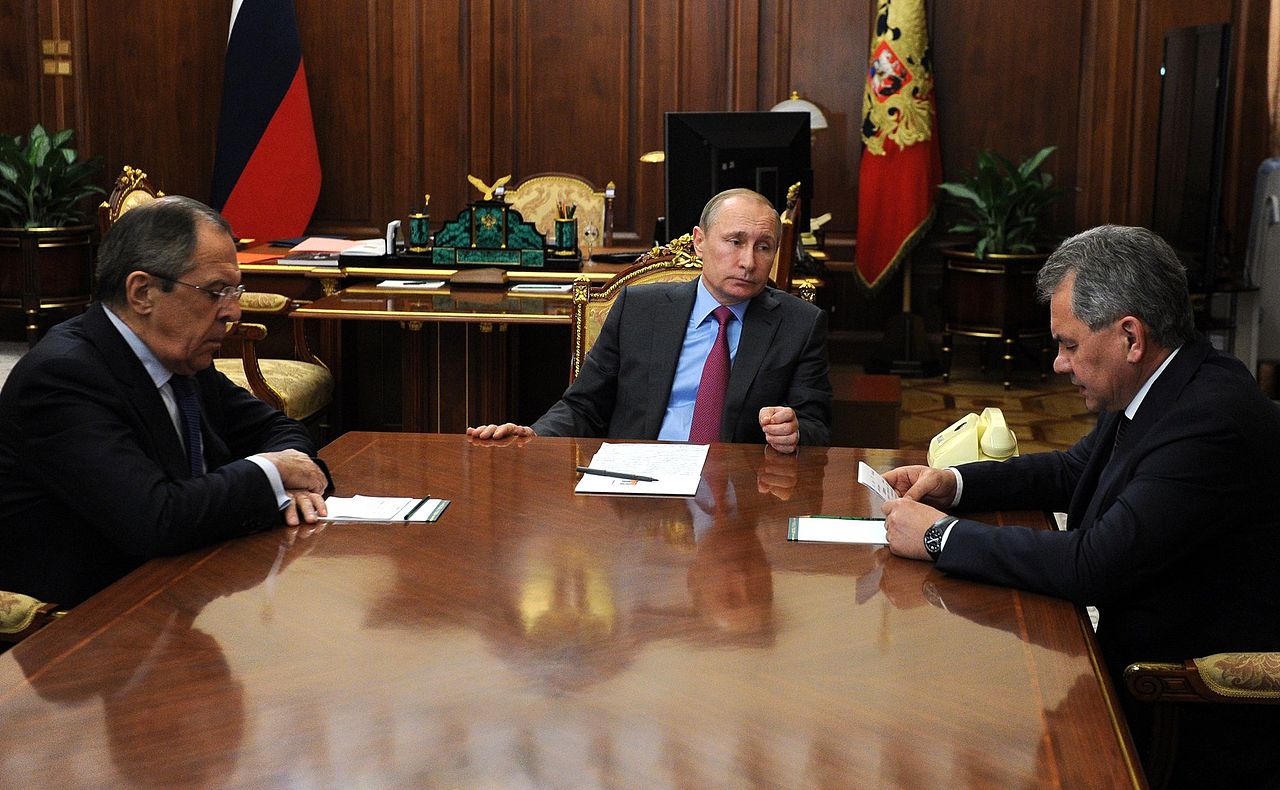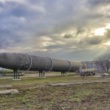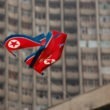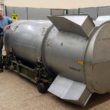On October 26, 2016, amid the hubbub of a rancorous American presidential election that dominated the headlines, an event took place in Russia that escaped the attention of those not otherwise involved in monitoring the esoteric world of strategic weapons research and development. This event, a test of a ballistic missile carrying a payload known as “Object 4202,” fundamentally changed the landscape of arms control, built as it is on the dual pillars of nuclear deterrence and missile defense.
“Object 4202” was a new kind of weapon, a hypersonic warhead capable of speeds 15 times the speed of sound, and capable of evading any anti-missile system the United States has today, or may develop and deploy for decades to come. While the October 26 test used an older RS-26 intercontinental ballistic missile (ICBM) as the launch vehicle, “Object 4202” will ultimately be carried on a newer ICBM, the RS-28.
The RS-28 is itself a wonder of modern technology, capable of flying in excess of five times the speed of sound, altering its trajectory to confuse anti-missile radars, and delivering 15 independently targetable nuclear warheads (each one 10 times as powerful as the bombs the United States dropped on Japan at the end of the Second World War) or three “Object 4202” hypersonic warheads, which destroy their targets through kinetic energy (i.e., through impact).
A nuclear warhead-armed RS-28 would take about 30 minutes to reach the United States from a silo in central Russia; its warheads would be capable of destroying an area about the size of Texas. Armed with the “Object 4202” hypersonic warheads, each of which is capable of destroying an American missile silo, the time would be cut down to 12 minutes or less. The RS-28 ICBM, scheduled to become operational in 2018, assures Russia the ability to annihilate the United States in retaliation for any American first-strike, while providing Russia a silo-killing first-strike capability of its own.
Since the dissolution of the Soviet Union in 1991, Russia has relied on the threat of massive nuclear retaliation as the foundation of its nuclear deterrence strategy, grounded in the notion of “mutually assured destruction,” where any nuclear strike by one side would result in a devastating response by the other, thereby reducing the chance of nuclear war.
The glue that held this theory of mutual nuclear suicide together was the 1972 anti-ballistic missile (ABM) treaty, where the Soviet Union and the United States agreed to limitations on the deployment of anti-missile defenses. An effective ABM capability gave a nation the theoretical ability to “win” a nuclear war by launching a debilitating first strike, and then destroying in-flight any missiles that survived. Limiting ABM defenses curtailed an arms race by reducing the impetus to develop new weapons capable of breaching an opponent’s defenses.
Effective arms control negotiations must include an appreciation of history, a realistic assessment of the present, and the ability to project into the future.
The ABM treaty provided a foundation of strategic stability, built on the precepts of “mutually assured destruction,” that enabled both the United States and the Soviet Union to enter into meaningful arms reduction agreements, including the ground-breaking Intermediate Nuclear Forces Treaty of 1987, and the Strategic Arms Reduction Treaty of 1991. (Ironically, it was President Reagan’s insistence in 1986 on continuing the research on the “Star Wars” anti-missile system, that precluded the possibility of eliminating nuclear weapons altogether.)
This trend toward nuclear disarmament continued in the decade following the collapse of the Soviet Union, with President Bill Clinton signing a new START 2 treaty with Russian President Boris Yeltsin in 1993. START 2 eliminated the deployment of multiple warheads on ICBMs, further stabilizing the strategic balance between the two nations.
The START 2 treaty never entered into force. In 2002, George W. Bush’s administration withdrew from the ABM Treaty, citing the need to develop defenses against missile launches from so-called “rogue states,” like Iraq, Iran, and North Korea. In doing so Bush unhinged the foundation upon which U.S.-Russian strategic arms control was built.
A new arms reduction treaty, signed in 2003, stripped away on-site, inspection-based verification, and did nothing to limit the deployment of ICBMs armed with multiple warheads. While the “New START Treaty,” signed by the Obama administration in 2010, brought back limited on-site inspections, there was no prohibition against ICBMs with multiple warheads.
Moreover, the Obama administration continued to develop and deploy anti-missile defenses, both in the United States and in Europe, resurrecting in Russia Cold War-era concerns that the Americans would leverage this new ABM capability to subject Russia to nuclear blackmail, threatening a nuclear strike for which Russia would have no response. The RS-28 missile system, inclusive of “Object 4202,” can trace its origin to American deployment of ABMs.
These concerns were on display on December 22, 2016, when President Putin delivered a speech that made the recent Russian developments public. “We need to strengthen the military potential of [Russia’s] strategic nuclear forces,” Putin said, “especially with missile complexes that can reliably penetrate any existing and prospective missile defense systems.”
This speech would have more than likely been buried by the American media save for one person—President-elect Donald Trump, who on the same day as Putin’s speech tweeted a reply: “The United States must greatly strengthen and expand its nuclear capability until such time as the world comes to its senses regarding nukes.”
The president-in-waiting then doubled down on this line of thinking, telling the hosts of MSNBC’s “Morning Joe” program the following morning, “Let it be an arms race! We will outmatch them at every pass and outlast them all.”
The Russian response was surprisingly muted. Russia, Putin said the following day, was not seeking a new arms race, but only to improve its capabilities in the face of American deployments of anti-missile defenses. Russia was now strong enough to repulse any aggressor, Putin said. “As for Donald Trump, there is nothing new about it; during his election campaign he said the U.S. needs to bolster its nuclear capabilities and its armed forces in general,” the Russian president noted.
During the campaign, candidate Trump had been infamously unfamiliar with the basics of American nuclear strategy. At a primary debate, after the moderator underscored the age of America’s nuclear arsenal (“The B-52’s [a nuclear-capable bomber] are older than I am. The missiles are old. The submarines are aging out”), Trump was asked, “What’s your priority among our nuclear triad?” The best the future President could come up with was, “I think…I think, for me, nuclear is just the power, the devastation is very important to me.”
There is no doubt that Trump received a more detailed briefing on America’s nuclear capability upon being elected. The aging American nuclear arsenal, he would have learned, is a critical national security issue. A new stealth bomber is in development, as is a new class of ballistic-missile submarines. And the Obama administration had initiated a process for producing and deploying a new ground-launched ICBM that would cost the American public $1 trillion over the course of the next decade. This perceived weakness, combined with Putin’s public pronouncement of Russian strength, apparently was enough to set the president-elect off on his tweeting and morning-talk-show rant.
A few days shy of his inauguration Trump seemed to have a change of heart. In a wide-ranging interview with British journalists, Trump noted that, “They have sanctions on Russia—let’s see if we can make some good deals with Russia.” What deal was Trump suggesting? “For one thing, I think nuclear weapons should be way down and reduced very substantially, that’s part of it. But Russia’s hurting very badly right now because of sanctions, but I think something can happen that a lot of people are going to benefit.” (The Times of London speculated that the first foreign policy trip President Trump would embark on would be a nuclear disarmament summit with President Putin; a Trump spokesperson rejected this as “false news.”)
While Russian president Vladimir Putin, in a January 28 phone call with President Trump, was warm to the idea of nuclear disarmament talks with a Trump administration, the Russians overall were dismissive of a deal that traded disarmament for the lifting of sanctions. An offer to engage in nuclear arms control talks, Russia’s Foreign Minister, Sergei Lavrov noted, would be furthered by first reviewing the issue of U.S. sanctions against Russia. But there could not be any direct linkage between the two. The Russian Foreign Minister also noted that the agenda for any such negotiations should include hypersonic weapons, U.S. missile defenses, space weapons and nuclear testing—in short, a broad range of inter-connected issues that the new Trump administration appears ill-equipped to handle at this juncture.
Rex Tillerson, the new secretary of state, has been silent on U.S.-Russian nuclear disarmament. And James Mattis, the new secretary of defense and the one Trump cabinet official who has opined publicly about disarmament issues, appears supportive of fielding a new land-based ICBM, thereby closing the door on the possibility of trading those weapons in exchange for similarly deep cuts by Russia. In his testimony before the Senate Armed Services Committee, Mattis noted that these missiles would be “a cost-imposing strategy on an adversary,” noting that “any enemy that wants to take us on is going to have to commit two, three, four weapons to make sure they take each one out.”
James Mattis would do well to speak to the men and women who operate America’s land-based ICBM force today. The Cold War is over, and these missiles no longer stand on the frontline of American defense. If the best reasoning for the continued deployment of land-based ICBMs is that they serve as a sump for a potential enemy attack, then there is no real justification for their existence, now or in the future.
President Trump reportedly told President Putin, during their January 28 conversation, that the current arms control treaty, up for renegotiation in 2018, was one sided in favor of the Russians. With all due respect to Donald Trump, his American-centric view of the Obama-era arms agreement is moot; the U.S.-Russian arms race is over, and Russia has won.
The RS-28 missile will be operational next year; the new American land-based ICBM won’t be operational for another decade. Russia is on the verge of deploying a hypersonic, missile silo-killing weapon that undermines the secretary of defense’s thin justification for a new land-based ICBM. Every missile system Russia deploys, or will deploy, is capable of defeating America’s missile defense systems, including what is currently deployed and what is envisioned for the future. And Russia is on the verge of completing the deployment of its own anti-missile shield, one that will seal off its air space to bombers, cruise missiles, and ballistic missiles, negating in totality America’s nuclear triad.
There is a deal to be made with Russia, and it doesn’t involve trading the lifting of sanctions for nuclear arms cuts. President Trump would do well to accept Sergei Lavrov’s proposed disarmament agenda, and expand it to include a new ABM treaty and a new disarmament treaty that not only reduces the numbers of weapons on both sides, but also would include the elimination of multiple warheads on all missiles, land-based and submarine launched.
Effective arms control negotiations must include an appreciation of history, a realistic assessment of the present, and the ability to project into the future. At this juncture, the Trump administration has not demonstrated the level of competence needed to successfully conclude such a complex negotiation. The first step, however, is to embrace disarmament as a positive goal. While President Trump has shown a limited understanding of the nuclear triad, his recognition that nuclear weapons should be “way down and reduced very substantially” is a step in the right direction.
Former Marine intelligence officer Scott Ritter served on the staff of General Norman Schwarzkopf during the Gulf War and as a U.N. weapons inspector in Iraq from 1991–1998. He is the author of several books.






Well, this is certainly a “Holy S**t, Batman!” story. Uninformed men (yes) making a lot of bluster can only make things worse until we end up saying, “Da, da, esteemed leader.” Anyone who is as full of bluster and puffed up confidence as our new leaders appear to be is actually extremely fearful and insecure. Even if he hides it from himself. Freud called this a reaction formation and it is the same as Hamlet’s Queen mother who complained that the queen in the play, “doth protest too much.”
This is quite scary to be honest. If these two countries fight each other, most of the 3rd world countries might be victims of being collateral damages. Just hope they stay low and avoid any mistakes.
Thanks to Scott Ritter for advocating a nuclear arms agreement with Russia to include a new ABM treaty, further reduction of number of weapons, and elimination of multiple warheads on missiles. But Ritter greatly overestimates any advantage Russia might have over the US in the race to oblivion.
When it comes to anti-ballistic missile “defenses,” they are in reality proposed to enhance an offensive first strike by limiting retaliation. But anyone–Russian or American–who thinks the other side’s second strike capability can be even meaningfully thwarted lives in a fantasy world. That’s why deterrence is the only game in town. But perceptions are another matter, and feeding the first-strike fantasy as Ritter does only ramps up the paranoia on both sides.
A more important issue, not addressed by Ritter, is a country’s capability to initiate nuclear warfare into the European battlefield with very low-yield weapons, thus putting the burden on the other side whether to take the next step up the ladder of escalation. And here the US, with its small-yield nukes deployed up to Russia’s borders, has the decided advantage, one we hope will never be used if the Europeans have the good sense to move to neutrality between the two nuclear superpowers.
Ritter says a nuclear-armed Russian RS-28 missile (with 15 warheads, each about 200 kT, i.e., 10 “Hiroshimas”) could destroy “an area about the size of Texas.” That’s nonsense since the average large Texas’s city covers a large area, and a number of 200-kT weapons (with blast radius to destroy concrete structures of about 5 miles) will be required to wipe out each city. So we’re talking about destroying at most 7 or 8 large cities in Texas.
The last thing we need in this discussion is an unrealistic exaggeration of one side’s advantages. There will be no winners in a nuclear exchange and as it stands, neither side has won the arms race.